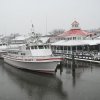Lewes is a historic town filled with many stories. One such story is that of the Unknown Sailors Cemetery, which is commemorated by a single plaque at the Lewes ferry terminal.
The story of this cemetery begins in the 17th century when Lewes was developing into a thriving port city. Lewes was an important seacoast town servicing ships as they transited the East Coast of America. These vessels were often subject to an unforgiving sea that claimed thousands of ships and lives. In many cases, the bodies of these unfortunate souls ended up on the shoreline of Lewes and other beaches along the coast. Local cemeteries were generally for a city’s respective parishioners, not for unknown people who may not have been of the proper faith. This made it necessary to provide an alternate cemetery. As a result of these unfortunate circumstances, an unknown sailor’s cemetery was established.
I was surprised to find that a large number of people are buried at this location. My research indicated 1,500 to 3,000 bodies were buried there over the course of several hundred years. I would imagine when a body was discovered on the shore or recovered from a wreck, they were simply taken to this cemetery and buried in the sandy soil. A few bodies found their way to local cemeteries as was the case with Capt. Drew of the HMS DeBraak who is buried in the St. Peter’s cemetery in Lewes.
Lewes was not the only seaside town experiencing shipwrecks and bodies washing ashore. This problem was so severe along the entire East Coast and other waterways that the U.S. government established the U.S. Life-Saving Service in 1848. Its job was to save lives, a dangerous task considering they were required to rescue people in any weather or the roughest of seas. Their unofficial motto was, ”You have to go out, but you don’t have to come back.” I am sure many of the bodies found by the USLSS ended up in an unknown sailors cemetery. Today, both Lewes and Rehoboth have USLSS station museums you can visit.
I had the great fortune to be able to speak with several locals who remembered the cemetery and had stories that confirmed the location of the cemetery. Unfortunately, those sources have since passed on, including Hazel Brittingham, recognized as the foremost historian of Lewes. She recalled that a friend of hers who lived quite close to the cemetery had a son that brought home a human skull found at the old cemetery. Her friend was horrified and ordered her son to immediately take it back to where he found it.
Another local who grew up next to the cemetery told me that when he was a kid, he remembered seeing bodies being buried there during World War II. German submarines torpedoed numerous ships off the Delaware coast during the war. Those victims who could not be identified most likely ended up in the cemetery. He went on to describe the cemetery as sand, dune grass and a few wooden crosses. Eventually, all signs of the cemetery disappeared.
In 1963, the Delaware River and Bay Authority began construction of the ferry terminal despite protest from locals who did not want to see the cemetery disturbed. During the construction period, no bodies were removed, according to one of my sources. The area was leveled and eventually paved over. In 1964, ferry service began between Lewes and Cape May, N.J.
Oddly enough, under Delaware Code, Title 7 (established in 1953), Chapter 53, Paragraph 5101 identifies the exact location of the cemetery. Paragraph 5102 designates the Delaware Society for the Preservation of Antiquities to maintain and reconstruct the cemetery. Apparently, the cemetery was sacrificed for commerce and profit. And so ends the story, or has it?
There are rumors the Lewes ferry terminal and Pilots Association building are haunted by the spirits of those buried in this mostly forgotten cemetery. In 1983, a plaque was erected at the ferry terminal identifying the area as a cemetery. Apparently this marker has not satisfied the spirits of those who perished.























































